MIKROGEN recomLine Toxoplasma IgG [Avidity] recomLine ...
MIKROGEN recomLine Toxoplasma IgG [Avidity] recomLine ...
MIKROGEN recomLine Toxoplasma IgG [Avidity] recomLine ...
Create successful ePaper yourself
Turn your PDF publications into a flip-book with our unique Google optimized e-Paper software.
E<br />
<strong>Toxoplasma</strong> gondii<br />
<strong>MIKROGEN</strong><br />
molekularbiologische Entwicklungs-GmbH<br />
C 0483<br />
Line Assay<br />
<strong>recomLine</strong> <strong>Toxoplasma</strong> <strong>IgG</strong> [<strong>Avidity</strong>]<br />
<strong>recomLine</strong> <strong>Toxoplasma</strong> IgM<br />
<strong>recomLine</strong> <strong>Toxoplasma</strong> IgA<br />
Strip-Immunoassay with antigens produced by recombinant techniques for the detection<br />
of <strong>IgG</strong>, IgM and IgA antibodies against <strong>Toxoplasma</strong> gondii.<br />
<strong>Toxoplasma</strong> gondii shows the highest incidence of any human pathogenic parasite in<br />
central Europe. As a rule, the course of the infection is asymptomatic or mild and<br />
confers lifelong immunity on immunocompetent persons. Initial contact with the pathogen<br />
during pregnancy can result of transmission of the pathogens to the foetus, resulting<br />
in severe damage to it.<br />
The main task of routine diagnostics is thus within the framework of preventive<br />
examinations during pregnancy. Due to the asymptomatic genesis of a toxoplasmosis<br />
in most cases, diagnostic detection is in most cases serological. It is very important to<br />
differentiate acute infections from long past infections. A problem is presented in this<br />
respect by the tendency of the <strong>Toxoplasma</strong>-specific IgM antibodies to persist for months<br />
and even years after initial contact, so that detection of IgM is not a sufficient criterion<br />
for an acute toxoplasmosis infection. The most important differential characteristic is<br />
thus the avidity of the <strong>Toxoplasma</strong>-specific <strong>IgG</strong> antibodies.<br />
The <strong>recomLine</strong> <strong>Toxoplasma</strong> is designed as a confirmation test on the basis of antigens<br />
sprayed onto nitrocellulose strips. The line assay technique facilitates detection and<br />
identification in a single test charge and at a single glance of <strong>IgG</strong>, IgM or IgA antibodies<br />
against highly specific genetically engineered <strong>Toxoplasma</strong> antigens. In addition, the<br />
avidity of the <strong>IgG</strong> antibodies to each of the respective antigens can also be determined.<br />
React. Contr.<br />
Conjugate Contr.<br />
<strong>IgG</strong><br />
IgA<br />
IgM<br />
Cut-off Contr.<br />
ROP1<br />
MAG1<br />
SAG1<br />
GRA7<br />
GRA8<br />
n Product advantages<br />
• Recombinant antigens, therefore:<br />
➣ High sensitivity and specificity<br />
➣ Easy and clear interpretation due to easy to read bands<br />
• Easy test procedure; automation possible<br />
• Test procedure is identical to other <strong>MIKROGEN</strong> strip tests<br />
• Safe evaluation due to strip specific controls (cut-off and conjugate control)<br />
• Separate detection of <strong>IgG</strong>, IgM and IgA antibodies possible<br />
• Easy and reliable determination of avidity possible<br />
• C label: The <strong>recomLine</strong> <strong>Toxoplasma</strong> tests meet the high standard of the EC directive 98/79/EC on<br />
in vitro diagnostic medical devices<br />
• Most accurate determination of stage of infection<br />
n Related recombinant <strong>Toxoplasma</strong> antigens<br />
Antigen<br />
A bbreviation<br />
Molecular weight [kDa]<br />
Rhoptry<br />
antigen<br />
ROP1<br />
66<br />
Matrix<br />
antigen<br />
MAG1<br />
65<br />
Surface<br />
antigen<br />
SAG1<br />
30<br />
Granular<br />
antigen<br />
GRA7<br />
29<br />
Granular<br />
antigen<br />
GRA8<br />
35
n Testprinciple and Procedure<br />
1 st Incubation: A test strip loaded with <strong>Toxoplasma</strong> antigens is incubated<br />
with diluted serum or plasma in a dish for 60 min.<br />
wash 3 times<br />
E<br />
E<br />
E<br />
2 nd Incubation: Peroxidase conjugated anti-human antibodies (<strong>IgG</strong>, IgM or<br />
IgA specific) are added. Incubate for 45 min.<br />
wash 3 times<br />
3 rd Incubation: 5 - 10 minutes after addition of the coloring solution, insoluble<br />
colored bands develop at the sites on the test strips occupied<br />
by antibodies.<br />
n Data<br />
Course 1<br />
4 w<br />
12 w<br />
CutOff<br />
ROP1<br />
<strong>IgG</strong><br />
MAG1<br />
SAG1<br />
GRA7<br />
GRA8<br />
Avid.<br />
Avid.<br />
CutOff<br />
ROP1<br />
IgM<br />
MAG1<br />
SAG1<br />
GRA7<br />
GRA8<br />
<strong>IgG</strong> antibody titer<br />
GRA7<br />
MAG1<br />
SAG1<br />
40 w<br />
Avid.<br />
low<br />
<strong>Avidity</strong><br />
high<br />
Course 2<br />
3 w<br />
4 w<br />
12 w<br />
w = weeks. Displayed are the assumed time intervals after infection.<br />
Avid.<br />
Avid.<br />
Avid.<br />
Course of two <strong>Toxoplasma</strong> infections.<br />
Course 1 covers a period of approx. 40 weeks. Course 2 covers a<br />
period of approx. 11 weeks. The time of infection is estimated in both<br />
cases. The early increase in antibodies to GRA7 and GRA8 and the<br />
approx. 4-week delay before the antibodies to MAG1 and SAG1 then<br />
increase as well are characteristic. The early phase of the infection is<br />
also characterized by low-avidity <strong>IgG</strong> antibodies (apparent in the<br />
"flushed-off" bands). In the advanced phase of the infection, the avidity<br />
of the <strong>IgG</strong> antibodies to first GRA7 and later SAG1, MAG1 normally<br />
rises.<br />
Time after infection<br />
Phase I Phase II Phase III Phase IV<br />
3-4 Weeks 2 Months > 1 Year<br />
Model course of maturation of <strong>IgG</strong> antibodies to<br />
<strong>Toxoplasma</strong> gondii antigens.<br />
In most <strong>Toxoplasma</strong> gondi infections, antibodies to the granular<br />
antigens GRA7 and/or GRA8 are produced at first. Antibodies<br />
to MAG1 and/or SAG1 usually do not occur until four weeks<br />
later. The titre of SAG1 antibodies usually does not rise as<br />
sharply as that of the antibodies to GRA7, GRA8 and MAG1.<br />
An important parameter in evaluation of infection status is the<br />
avidity of the <strong>IgG</strong> antibodies (shown as increasing line width).<br />
Remember, only the avidity of the <strong>IgG</strong> antibodies to SAG1,<br />
MAG1 and GRA7 remains constantly high. The avidity of <strong>IgG</strong><br />
antibodies to other <strong>Toxoplasma</strong> gondii antigens are of no use<br />
for the determination of the infection status.<br />
Phases of infection: The switch from phase I to phase II is<br />
approximately marked by MAG1 antibodies with intermediate<br />
avidity - MAG1 antibodies with high avidity can exclude an<br />
infection within the last three months. The avidity of SAG1<br />
antibodies is then often still low. The phase III is definetily<br />
reached when SAG1 antibodies display high avidity. Phase IV<br />
is marked by the absence of IgM antibodies against <strong>Toxoplasma</strong><br />
gondii antigens.<br />
n Storage and Shelf life<br />
At 4 °C, 18 months from the time of production<br />
n Commercial Product Article No. 5972 <strong>recomLine</strong> <strong>Toxoplasma</strong> <strong>IgG</strong> [<strong>Avidity</strong>]*<br />
Reagents for 25 determinations<br />
* [ ] optional available<br />
as additional reagent<br />
Article No. 5973<br />
Article No. 5971<br />
Article No. 11010<br />
<strong>recomLine</strong> <strong>Toxoplasma</strong> IgM<br />
Reagents for 25 determinations<br />
<strong>recomLine</strong> <strong>Toxoplasma</strong> IgA<br />
Reagents for 25 determinations<br />
Blot, Line - avidity reagent<br />
Reagent for 25 avidity determinations<br />
<strong>MIKROGEN</strong> GmbH<br />
Floriansbogen 2-4 · D-82061 Neuried · Germany · Tel.: +49 (0)89 54801-0 · Fax: +49 (0)89 54801-100<br />
Internet: www.mikrogen.de · eMail: mikrogen@mikrogen.de<br />
pirltge006


![MIKROGEN recomLine Toxoplasma IgG [Avidity] recomLine ...](https://img.yumpu.com/31102397/1/500x640/mikrogen-recomline-toxoplasma-igg-avidity-recomline-.jpg)

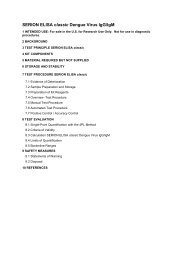
![MIKROGEN recomBlot CMV IgG [Avidity] recomBlot CMV IgM ...](https://img.yumpu.com/47840028/1/185x260/mikrogen-recomblot-cmv-igg-avidity-recomblot-cmv-igm-.jpg?quality=85)
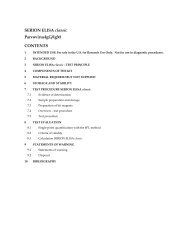
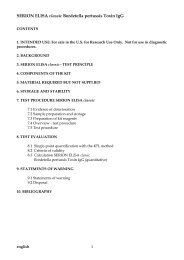
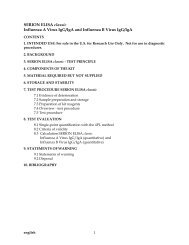

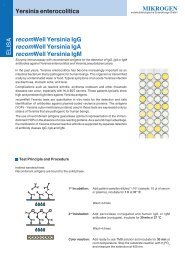
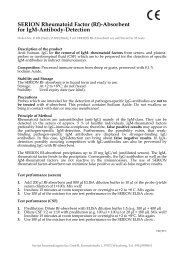

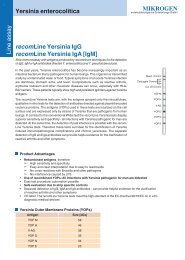
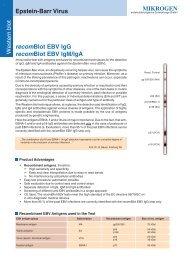
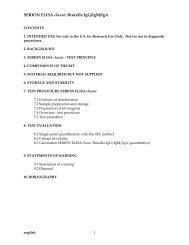

![MIKROGEN recomLine Parvovirus B19 IgG [Avidity] recomLine ...](https://img.yumpu.com/31102785/1/185x260/mikrogen-recomline-parvovirus-b19-igg-avidity-recomline-.jpg?quality=85)